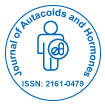Make the best use of Scientific Research and information from our 700+ peer reviewed, Open Access Journals that operates with the help of 50,000+ Editorial Board Members and esteemed reviewers and 1000+ Scientific associations in Medical, Clinical, Pharmaceutical, Engineering, Technology and Management Fields.
Meet Inspiring Speakers and Experts at our 3000+ Global Conferenceseries Events with over 600+ Conferences, 1200+ Symposiums and 1200+ Workshops on Medical, Pharma, Engineering, Science, Technology and Business
Editorial Open Access
A Decade Later
| Maria Kontoyianni* | ||
| Medicinal Chemistry, School of Pharmacy, Southern Illinois University Edwardsville, USA | ||
| Corresponding Author : | Maria Kontoyianni Assistant Professor in Medicinal Chemistry School of Pharmacy Southern Illinois University Edwardsville, USA E-mail: mkontoy@siue.edu |
|
| Received May 10, 2012; Accepted May 14, 2012; Published May 16, 2012 | ||
| Citation: Kontoyianni M (2012) A Decade Later. J Autacoids 1:e112. doi: 10.4172/2161-0479.1000e112 | ||
| Copyright: © 2012 Kontoyianni M. This is an open-access article distributed under the terms of the Creative Commons Attribution License, which permits unrestricted use, distribution, and reproduction in any medium, provided the original author and source are credited. | ||
Related article at Pubmed Pubmed  Scholar Google Scholar Google |
||
Visit for more related articles at Journal of Autacoids and Hormones
| Editorial | |
| It has been over a decade since the first draft of the human genome was published. At that time, the expectations regarding short and long-term impacts were high. In line with all new revolutionary undertakings, one needs to wonder whether projected outcomes were overly ambitious. As Francis Collins, director of the National Institutes of Health, astutely pointed out genomics has obeyed the Law of Technology that is expectations for dramatic results overnight proved to be unrealistic because short-term affects are historically overestimated, while long-term ones are underestimated. It would serve us well to first look at promises made back then regarding expected deliverables from genome sciences: 1) Gene therapy will materialize; 2) Personalized medicine will revolutionize treatment of human diseases by offering safer alternatives; 3) Pharmaceutical business models will need to adjust and reform. | |
| Gene therapy encompasses insertion of a foreign (therapeutic) genetic material into either the target organ or general circulation in order to correct a health disorder. Knowledge of all genes in the human body was expected to provide us with the tools to repair or replace ‘a’ defective gene, in particular since many health disorders result from genetic defects. The first gene therapy trials began in the early 1990s and mostly targeted single-gene hereditary disorders. These are diseases involving either a mutated gene, which then leads to protein deficiency, or synthesis of an abnormal protein with deleterious effects under the control of a mutated gene. Subsequent trials focused on non-hereditary, acquired disorders such as cancer, cardiovascular, and infectious diseases. Despite persistent trials in several disease categories, gene therapy has been elusive thus far. Repairing or replacing a defective gene may be a sensible aspiration at best, but identifying the vector that can lead to a therapeutic gene expression without adverse effects is not an easy task. If we factor in the complexity of acquired diseases, overexpressing a gene would be a single parameter to a multi-factorial, and sometimes not fully understood, phenomenon. | |
| Personalized medicine or targeted therapy promises selection of the right drug for the most relevant patient subpopulation. This implies development of genetic or other tests to identify patients with a particular genomic profile that can benefit from a drug without side effects. Linking biomarkers to therapeutics in the clinical development process has had some success in oncology with diagnostic/pharmaceutical combinations. HercepTest/Trastuzumab (Herceptin) from Dako/Genentech-Roche is effective in Her2-positive breast cancer patients, contrary to the mixed success of gefitinib (Iressa) with the EGFR companion test. As of September 2011, seventy-two personalized medicine drugs and diagnostics were listed, with twelve of them being required. | |
| Companion diagnostics promise to identify patients who will not respond favorably to a therapeutic. This brings us to the third point of the pharmaceutical business model, and its current blockbuster paradigm. Challenges in predicting the clinical utility of biomarkers, along with the very thought that a diagnostic may deter certain patients from taking a drug due to its potential lack of efficacy and safety, we would be naive to believe the pharma sector is going to embrace personalized medicine in its entirety. Projections of double-digit growth have plagued pharmaceutical developers for years, and despite substantial increases in R&D costs, productivity remains questionable. Consequently, therapies bringing in one million dollars in revenues per day, due to the number of patients, will remain attractive to drug makers. However, as has been the case with other technologies, pharmacogenomics (ability to test for gene variations through diagnostics toward targeted therapy) will serve as a complementary approach, rather than a replacement of the billion-dollar blockbuster drug. | |
| Does the above mean that genomics has not delivered? Not necessarily. What we have benefited from the human genome is an increased understanding of mechanisms of disease. It has helped us to better validate targets, which used to be a major wrinkle in the discovery process. It enables us to identify new targets for drug development via a thorough understanding of their role in disease. It also led to better designs of clinical trials. Finally, complete genomes of individuals are no longer an unrealized dream, but the objective of the Kaiser Permanente and the University of California, San Francisco collaborative study, which combined genetic information with the longitudinal clinical and health data of more than 100,000 people (http://www.genomeweb.com/ arrays/kaiser-permanente-ucsf-genotype-100k-people). We just need to remember that the field can decipher the underlying biology and relevance to disease, but cannot promise new therapeutics. |
Post your comment
Relevant Topics
Recommended Journals
Article Tools
Article Usage
- Total views: 13451
- [From(publication date):
November-2012 - Apr 03, 2025] - Breakdown by view type
- HTML page views : 8853
- PDF downloads : 4598
